The New York Times Magazine, January 14, 1990
A DARK LENS ON AMERICA
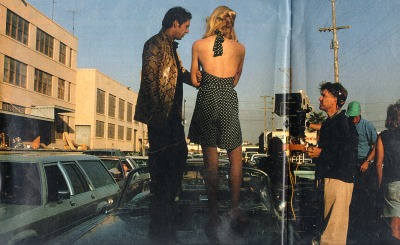
David Lynch directing Laura Dern and Nicolas Cage, young lovers pursued by sinister forces in a new film, "Wild at Heart."
The movies of David Lynch are absurd, macabre, even grotesque. Is Hollywood's reigning eccentric too weird for TV?
By Richard B. Woodward
AT THE EDGE OF THE FRENCH QUARTER IN New Orleans, where the city's charm falls off into skid row, David Lynch is directing a scene from his new film "Wild at Heart." On a scouting mission during the morning he had liked several of the people who gather here in the bars before noon, and has now decided to incorporate them into the shots. The action of the film, which stars Nicolas Cage and Laura Dern as young lovers, has the couple always on the run from sinister, adult forces. New Orleans is only one of their many hideouts. The script calls for Sailor to pick up Lula in his car at a seedy hotel; there's a bit of dialogue, then a drive-away. Lynch positions an older woman from the area by the hotel door, patiently coaching her about what he wants. "Ruthie, have a smoke, drink your beer and when they drive up, look over casually," he says through his speaker-horn from across the street. "Don't look at the camera, no matter what." On cue, Ruthie performs flawlessly, adding a sour note of realism to a throwaway scene.
A crowd of tourists and locals has gathered on the median strip to watch the film-making, giving Lynch another idea. He whispers to the assistant director, who whispers to his assistant: "Round up the 10 weirdest people you can find and get them ready. We're going to do it again." By the time the camera starts rolling, a group of 40 or 50 is standing on either side of the hotel door. This time, as Cage arrives for Dern, Lynch signals the crowd to shout "Goodbye, Sailor! Goodbye, Lula!", after which Cage floors the '65 Thunderbird convertible, leaving a patch of rubber on the street and the director beaming. "That was fun," he says.
Whichever take eventually passes the final cut - gritty and low-key or off-the-charts euphoric - it will bear the mark of David Lynch, a homegrown surrealist whose love for dark and light extremes yields a warped revision of common American places and experience. His eye for the absurd detail that thrusts a scene into shocking relief and his taste in risky, often grotesque material has made him, perhaps, Hollywood's most revered eccentric, sort of a psychopathic Norman Rockwell.
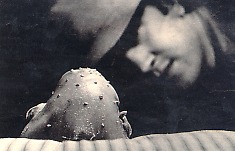
Lynch, above, with the mutant baby in his 1977 feature debut, "Eraserhead."
Below: Isabella Rossellini and Kyle MacLachlan in "Blue Velvet," Lynch's eerie, erotic detective story produced in 1986.
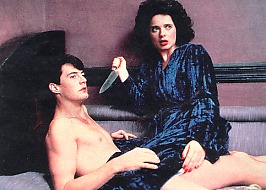
From his astonishing feature debut, "Eraserhead," in 1977, through his first mainstream success with "The Elephant Man" in 1980, which earned him two Academy Award nominations (best director and best adapted screenplay), through "Blue Velvet," his erotic detective story that won the National Society of Film Critics Award for Best Film of 1986, Lynch has developed a peculiar signature. Within established moods of dread and mystery, disturbing things happen in the frame or on the soundtrack. A low wind blows throughout "Eraserhead," which features an evening meal in which chickens suddenly move their wings and spout blood. The criminal Frank Booth in "Blue Velvet," played by a maniacal Dennis Hopper, needs an oxygen mask to reach orgasm, and he terrorizes people while quoting Roy Orbison. There is an ominous and exciting sense in a Lynch film that anything could befall his characters. And that they take in stride any number of bizarre circumstances gives them comic dimension, which often only serves to make the scary parts even scarier.
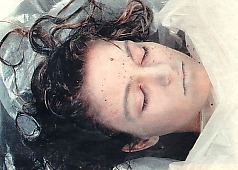
Above: "Twin Peaks," Lynch's new series for ABC, centers on a murder investigation in a small town. Sheryl Lee plays a homecoming queen whose body washes up on a beach.
From the beginning, his films have raised issues of exploitation. "Blue Velvet," a critical and commercial triumph, nonetheless brought charges that Lynch relished its kinky sex and violence. Some critics deplored the treatment of the character Dorothy Vallens, who enjoys being beaten up. Many people feel uncomfortable sitting through his films, acknowledging at the same time that they can't stop watching them. Pauline Kael of The New Yorker, a critic who admired "Blue Velvet," reported overhearing someone say upon exiting the movie: "Maybe I'm sick, but I want to see that again." Lynch doesn't censor his most unsavory fantasies; they go right up there on the screen.
"David is plugged into the American psyche," says Harry Dean Stanton, who plays a private detective in the new film. "He takes things to the edge, which we're badly in need of now." Whether to the edge or beyond it, Lynch makes movies that resemble no one else's. And however much he may be wired into the country's nightmares, he is even more in tune with himself - with the tensions between the security and wonder of childhood and something adult, unknown and dangerous. Despite two marriages, two divorces and two children, Lynch has managed to stay very much a curious boy for whom the world is alive with discoveries, both good and evil.
EVERYONE WHO MEETS DAVID LYNCH FOR THE FIRST TIME is struck by how normal and clean-cut he seems. His work often brings to mind the European surrealists Bufiuel and Cocteau, but in person he is wholesomely American. His body is average, unathletic; the hair thick and conservatively styled. He usually wears white socks and keeps the top button of his shirt fastened - a retro 1950's look, as though he were still in grade school instead of 43 years old. Mel Brooks, who produced "The Elephant Man" and hired Lynch to direct it, calls him "Jimmy Stewart from Mars"; and Lynch certainly shares the actor's sweet face and folksy voice - haltingly sincere, twangy.
But to talk to him means first to catch him. For the last year-and-a-half Lynch has been on a creative tear that allows little time for anyone not involved in his many projects. Dino De Laurentiis's film company, which produced Lynch's "Dune" (an adaptation of Frank Herbert's science-fiction classic) as well as "Blue Velvet," went bankrupt in 1988, tying up the director in several scripts that were never filmed. As if to make up for this frustration and lost time, Lynch has exploded with an array of new work.

His status as a cult figure - on the order of Laurie Anderson or David Byrne - allows him access to other media. In addition to "Wild at Heart," which is now in post-production and scheduled for fall release, he continues to make and exhibit his soft, moody paintings that float between abstraction and figuration. He has produced and written lyrics for an album by the singer Julee Cruise, whose "Mysteries of Love" was the closing number in "Blue Velvet." And last November he came to New York for a performance at the Brooklyn Academy of Music of his "Industrial Symphony No. I." A theatrical work he wrote and directed with the composer Angelo Badalamenti, it included a midget who sawed wood on stage, a half-nude woman acrobat and a finale in which dozens of baby dolls were lowered on strings from the catwalk.
Perhaps most remarkably, Lynch is about to infiltrate prime-time television. "Twin Peaks," a series that he co-wrote and co-directed, will be seen on ABC in the spring. Rather than the bowdlerized, shrunken show one might expect, "Twin Peaks" is unmistakably Lynch. It's an intense fantasy about high-school life in a Northwest mill town following the murder of a prom queen, who turns out not to be as pure as everyone thought. The series explores the town's involvement in her death and the F.B.I. investigation of it. It's kind of a languorous, finely textured soap opera, injecting the form with hallucinatory power. Like the director himself, it is conventional but crazily bent.
A hint that Lynch is not as prosaic as he looks is dropped after we sit down for lunch at one of his favorite Manhattan restaurants, Jerry's in SoHo. Lynch has many rituals. On the New Orleans set of "Wild at Heart" he would retreat every day at lunchtime for meditation, a practice he has followed for 17 years. Another ritual, it turns out, is restaurants. He likes to eat at the same place and order the same thing every day. He was at Jerry's the day before, and knows what he wants.
"I'm in something of a crisis because I heard something about combining certain foods and their chemical reactions," he says, between bites of his BLT. "Now I really don't know what to eat anymore because everything I eat is wrong and I don't know what to eat that's right. It's not just a problem for me but for millions of people."
He isn't kidding. He looks genuinely worried as he pops another french fry into his mouth. This is a man who has kept his house in the Hollywood Hills largely unfurnished for years so that he "wouldn't have to think about it." He also didn't want people to visit him there. "I was doing things I didn't want them to see," he says. Pressed about what those might be, he will say only: "Things."
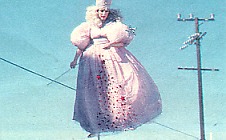
"I like things to be orderly," he says, still on the specifics of food. "For seven years I ate at Bob's Big Boy. I would go at 2:30, after the lunch rush. I ate a chocolate shake and four, five, six, seven cups of coffee - with lots of sugar. And there's lots of sugar in that chocolate shake. It's a thick shake. In a silver goblet. I would get a rush from all this sugar, and I would get so many ideas! I would write them on these napkins. It was like I had a desk with paper. All I had to do was remember to bring my pen, but a waitress would give me one if I remembered to return it at the end of my stay. I got a lot of ideas at Bob's."
Talking to Lynch can be like interviewing a teen-ager. He uses words such as "neat," "thrilling" and "coolest," as in describing two of his favorite directors: "Kubrick is the coolest, and Marty" - Scorsese - "is right next door." Lynch shies away from critical analysis, either for fear that he will jam the flow of images or because he honestly doesn't know where his ideas come from. "They're based in abstraction or nature," he says vaguely, although a high sugar intake is another explanation.
Isabella Rossellini, who played the tortured Dorothy Vallens in "Blue Velvet" and is now Lynch's romantic companion, calls him "seraphic, blissed. Most people have strange thoughts, but they rationalize them. David doesn't translate his images logically, so they remain raw, emotional. Whenever I ask him where his ideas come from, he says it's like fishing. He never knows what he's going to catch."
This angelic medium is at the same time firmly grounded. He gardens and builds things. On the set he is preternaturally calm and sure of what he wants. Responsible, aware of budgets and schedules, he almost never storyboards a scene, leaving himself open to chance or suggestion. He is not a flake. Like a true subversive, he can pass for ordinary.
"I didn't know what to expect when I met David," says Gary S. Levine, vice president for dramatic series development at ABC, "but what you get is a gentle, almost timid person with a very clear vision that he adheres to. He's incredibly responsible and focused. 'Twin Peaks' came in under budget and on time. I think it was all in his head even before he walked in the office."
BORN IN MISSOULA, MONT., IN 1946, Lynch is the son of a research scientist for the Department of Agriculture. The job moved the family around the Northwest, from Sandpointe, Idaho, to Spokane, Wash., and finally east to Alexandria, Va., where he went to high school. "Blue Velvet" and "Twin Peaks" clearly reflect this early all-American adolescence: growing up in lumber country with its small, mostly white communities, attending public schools, cruising downtown at night for kicks.
"As a teen-ager, I was really trying to have fun 24 hours a day," says Lynch. I didn't start thinking until I was 20 or 21. I was doing regular goofball stuff." According to the director Jack Fisk, who went to high school with him, Lynch and his girl friend were voted "cutest couple" and are pictured in the yearbook aboard a bicycle-built-for-two. "I think David has fought his upbringing in middle-class suburbia," says Fisk. "But a part of him is really attracted by that kind of stability. He knows it's an illusion, but he draws on it for his films."
Unlike many of his Hollywood contemporaries, Lynch did not grow up besotted with movies. Instead, he wanted to be an artist. He and Fisk had their own studio, which they painted black. Upon graduation, after Lynch had tried and hated the Boston Museum School, the pair set off for Europe to study with the expressionist painter Oskar Kokoschka. Planning to spend four years there, they lasted 10 days. Lynch moved back to Alexandria, to the chagrin of his parents, and proceeded to get dismissed from a succession of low-paying jobs.
It wasn't until he moved to Philadelphia, where he and Fisk enrolled at the Pennsylvania Academy of Fine Arts, that Lynch found himself. "I had my first thrilling thoughts in Philadelphia," he says. He often credits the city as the source of the visions in "Eraserhead," a slow, bleak film about a miserable couple and their mutant baby, set in a poor industrial landscape where it is always dark. "I started to appreciate the absurdity of life," he says. He would wake up at 5 o'clock in the afternoon, and work all night.
Lynch and Fisk rented a house in a crime-ridden poverty zone, next door to Pop's Diner and kitty-corner from the morgue. "David would dress up to visit the morgue," says Fisk. "He was fascinated, and he would always wear at least two ties, one for luck." In the neighborhood, at the time, murders were not uncommon. "I saw so many things in Philadelphia I couldn't believe," says Lynch. "I saw a grown woman grab her breasts and speak like a baby, complaining her nipples hurt. This kind of thing will set you back."
For an art contest at school Lynch made his first film: an animated 10-second loop that features six heads, which throw up and then catch on fire. He shared first prize. A fellow student, who loved the piece, gave Lynch $1,000 to build a sculpture with a working film loop in it for his living room. After working on it for months and exhausting the money, he discovered that a defect in the camera had produced "one long blur. There weren't even any frame lines." For some reason, he wasn't upset. "It was a very weird thing. I remember thinking I should be depressed." He looks back on this as "fate," the path that led him to filmmaking. Fate and luck are vital concepts for Lynch, who describes himself as "a Hindu, I guess."
With money from his father, Lynch made "The Alphabet," a four-minute film with animation and live action, but without a story. He sent it to the American Film Institute in Los Angeles, which gave him funds to make "The Grandmother," about a disturbed boy who plants a seed that grows into his grandmother.
Accepted into the institute's Center for Advanced Film Studies in 1970, Lynch studied with the Czechoslovak film maker Frank Daniel, whose course on film analysis shaped his writing and directing habits. "It's a simple thing he taught me," says Lynch. "If you want to make a feature film, you get ideas for 70 scenes. Put them on 3-by-5 cards. As soon as you have 70, you have a feature film." Except that he now dictates to an assistant, Lynch still works this way.
But dissatisfied again with school and divided between film and painting, he was prepared to quit. When the film institute asked him not to leave and to say what he really wanted to do, he said: "Eraserhead."
From 1971 through 1976, this obscure, terrifying, original film consumed Lynch and a small group of friends, with whom he has remained close. "David was developing a film grammar all his own," says the cinematographer Frederick Elmes, who also shot "Blue Velvet" and "Wild at Heart." Most of "Eraserhead" was shot at the Greystone Mansion, an estate in Beverly Hills then the headquarters of the American Film Institute, where Lynch was illicitly living after separating from his wife. With blankets over the windows, his room became his world. He would ask Elmes to padlock him in at night so the watchman wouldn't suspect.
In 1967, Lynch had married a fellow art student; a year later, their daughter Jennifer was born. It isn't hard to see in the film the terrors of someone who finds that he can't really handle the responsibility of fatherhood. One of the agonizing motifs of the film is that the helpless, monstrous baby never stops crying. "David went through a spiritual crisis when he was making 'Eraserhead,"' says Jack Nance, who played the befuddled husband. "That's when he developed his program of meditation."
In other interviews Lynch has talked about the importance of the "art life," in which the discipline and time required for making art takes precedence over everything else. "An artist's life is very selfish," he says today. "But it's thrilling to create something, and you need a certain set-up for the process to take place. You can't have a lot of obligations.
"It's not a hardship for me. It's a hardship only if I see I'm hurting other people. But maybe they were holding me back."
(He has remained on good terms with his former wives and his children. Next month, Jennifer Lynch, his 21-year- old daughter, will make her debut as a director with "Boxing Helena," a film she wrote herself. The story of a girl whose boyfriend cuts off her arms and legs and keeps her in a box, it is, in her words, "an obsessive modern-day love story." Asked about how much this plot may owe to the influence of her father, she says: "Actually, he was quite offended by the subject matter. But he thinks I've written a hell of a script.")
"Eraserhead" took five years to complete because Lynch kept running out of money; it was finished with help from many people, including his parents. In 1977, it opened at the Cinema Village in New York for a midnight show and, after a slow start, became a hit on the horror circuit in Los Angeles, San Francisco and London. That same year, Lynch married Jack Fisk's sister Mary (in 1982 they had a son, Austin) and, living in Los Angeles, began would could be called his "shed building" or "early Bob's Big Boy" period. As his only job he had taken a paper route delivering The Wall Street Journal and, with wood he collected on the streets, he built L-shaped, gable-roofed, and Egyptian-style additions to the garage in which they lived. He was perfectly content; he had discovered sugar, which he calls "granulated happiness."
But two years later, restlessness took him back to film as one of the writers of "The Elephant Man." After every studio turned down the script, Mel Brooks decided that his company, Brooksfilms, would produce it. When Lynch's name came up as a possible director, Brooks went to see "Eraserhead." After the screening, with Lynch waiting nervously outside, Brooks came out yelling "You're a madman, I love you, you're in."
The mood of "The Elephant Man," its palpable vision of blanketing darkness and pockets of light in industrial-age England, owes much to Lynch. And for the only time in his career, his gift for atmosphere was joined to a clear dramatic story: the relationship between the pathetically deformed John Merrick and his doctor. A box-office success, the film elevated Lynch above cult status. He was given money by Dino De Laurentiis to develop original scripts, one of which became "Blue Velvet."
But between these two hits, Lynch made "Dune," a $40 million disaster for De Laurentiis and an emotional failure for the director, who still finds it "extremely painful to talk about." A futuristic epic about dynastic families and a boy's coming to power on a waterless planet, "Dune" had chunks of narrative lopped off, without Lynch's consent, in order to run at normal theatrical length. A messy, sluggish film, it is nonetheless visually enthralling. "The experience taught me a lesson," says Lynch. "I would rather not make a film than make one where I don't have final cut."
On "Blue Velvet," Lynch had artistic control. With scenes that originated on the napkins at Bob's, it seems to have jumped out of the director's subconscious, the Freudian storyline innocent of textbook programming. Jeffrey Beaumont, a young man who has returned home to see his ailing father, finds a human ear while walking in the woods. This discovery, and the detective work that follows as he tries to determine its owner, leads him to uncover corruption in the heart of town and to witness, from a closet, a horrifying re-enactment of the primal scene between Dorothy Vallens and Frank Booth, whose oxygen mask resembles the gear his father wears in the hospital. Jeffrey enlists the aid of a high school girl, the daughter of a detective, and together they root out the villains. Love reconquers the world, darkness lifts, robins sing, and the boy's father is healed.
Both an X-rated Hardy Boys adventure and a riveting, study of the pleasures and dangers of voyeurism, "Blue Velvet" dramatizes a young man's fear of adults and his need to know more about grown-up sex and death. Many of Lynch's friends see Jeffrey Beaumont, played by Kyle MacLachlan, as a stand-in for the writer. "I saw so much of David in the Kyle character - his walk, his mannerisms," says Jack Fisk. This lack of distance can be unsettling; it feels as though we're peeping in on the director's own overheated fantasies. As Pauline Kael in her review: "If you feel that there's very little art between you and the director's psyche, it may be because there's less than the usual amount of inhibition." And if the happy ending seems ironic, too pat, given what Jeffrey has seen, both Lynch and Laura Dern, who played the coed Sandy Williams, disagree. "David is as much of a believer in the robins as in Frank Booth," she says.
AS HE HAS PAID ATTENTION to his childhood anxieties, Lynch has charged this material with his own, consistent film style: slow dissolves, spotlighting, extreme close-ups, figures who emerge out of darkness, shots held an extra beat to catch the sound and texture of a place or thing. He has an interest in facial deformities, exaggerated noise, sick puns and comically banal dialogue. Characters can be ridiculously specific. "Details give the film a certain quality," says Frederick Elmes. "It has to be that brand of beer to please David. He's thought a lot about the kind of car a character would drive." These details are often chronologically confused - brand names from different eras - so that everything takes place in dream time.
"Twin Peaks," the new television series, named for the small town in which it is set, includes all of these elements. It bears a direct relationship to "Blue Velvet;" the first image in the pilot - a bird in a tree - picks up from the robins. "I see my character as Jeffrey Beaumont grown up," says Kyle MacLachlan," who plays the Federal agent. "Instead of being acted upon, he has command of the world." However, the agent has his typical Lynchian quirks: he can't get used to the tall trees in the area, and he recites his every thought into a micro-cassette recorder.
The town itself is full of eccentrics: a woman who carries a log everywhere; a policeman who cries at the scene of any disaster, and a couple of budding, teen-age sociopaths. The cast includes Jack Nance, Michael Ontkean, Piper Laurie, Joan Chen, and, from the old television series "Mod Squad," Peggy Lipton. Indeed, the series is laced with references to other television shows (J. R. Ewing's initials figure in the plot), to "Sunset Boulevard" and to "West Side Story" (Richard Beymer and Russ Tamblyn, who played in the movie, are in the show).
As with "Blue Velvet," the town existed before the characters. "We drew a map," says Mark Frost, Lynch's co-writer and co-producer. "We started with the image of a body washing up on a lake. We knew the town had a lumber mill, but the specifics we weren't sure of." After three months of concentrated discussion, they wrote the script for the pilot in 10 days.
There are two versions: a two-hour video cassette that resolves the murder mystery; and the series, with the killer still unnamed after the first group of episodes. The sex and violence are underplayed in "Twin Peaks," although the murder involves drugs, flesh magazines and bondage; and the title of the show is a male joke about women's breasts. The Western landscape does, after all, prominently feature the Grand Tetons.
If there is one image that, for Frost, epitomizes Lynch's mind at work, it is the scene in the pilot in which the F.B.I. agent checks the body of the dead girl lying in the morgue. He is probing with tweezers for a bit of evidence he thinks may be lodged under her fingernail, an image many viewers may find unsettling. "David likes to get right under there, beneath the surface of things, and make people uncomfortable."
Lynch likes the scene too, but for other reasons: "The thing I love about it is that Kyle's obsessed. Not in a bad way. He's goofy."
"Everyone is a detective," he continues. "All of us want to know what's going on." Without trying to exploit an audience's fears, he concedes that he wants people "to sit in their seats differently."
"There is a magical line that you have to feel or you get into trouble," he says. "And sometimes you think that you feel it but you don't. It's interesting to go up to the line - you should go up to the line. But you shouldn't cross over. The fingernail is near that line."
Executives at ABC have only a vague idea how America will react to this eerie, experimental soap opera. "We did a cable test that was pretty positive," says Gary Levine. "Not overwhelming, but positive." The constraints of television, with its censors and blocks of time, don't seem to have bothered Lynch. "We lucked out on the pilot, and everything fit just right," he says. "But any time limit is arbitrary and absurd. There's no law that says you have to end a show at a certain time. Other countries don't end shows on the hour. I don't know which countries. But I heard they did."
The persistent violence of television, however, genuinely concerns him. "The worst thing about this modern world is that people think you get killed on television with zero pain and zero blood," he says. "It must enter into kids' heads that it's not very messy to kill somebody, and it doesn't hurt that much. That's a real sickness to me. That's a real sick thing."
AT JERRY'S, AS THE meal winds down, the only comestible left a half cup of coffee, Lynch deflects another question about the intricate process of his film-making. "I don't think about technique," he says."The ideas dictate everything. You have to be true to that or you're dead."
Whether or not a television audience can accept Lynch's weirder ideas, he has movies for his more unbridled fits of imagination. "Wild at Heart" is even more violent and sexually twisted than "Blue Velvet," and includes a torture scene so creepy - featuring a ritual resembling a carnival game, except that it involves masturbation, a gun and a pair of soda bottles - that Lynch was afraid to show it to anyone. "I thought they would lock me up," he says. The scene is nowhere to be found in Barry Gifford's book, the basis for the film. Where the idea came from, Lynch can't say.
The waiter walks over with a coffee refill, but Lynch puts his hand over his cup. "No thanks," he says with a smile. "I've finally got it mixed just the way I like it."
Back to the Lynch articles page